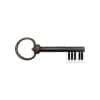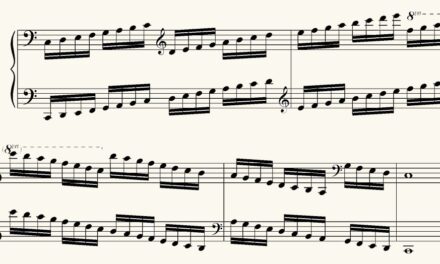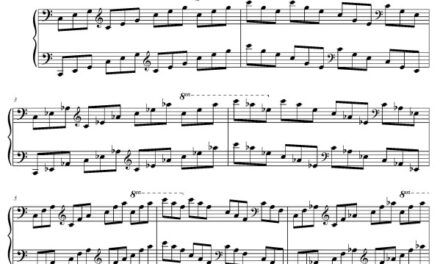PIANO FINGERING: THE KEYS TO FIGURING IT OUT
My students often have questions about how to find the best fingering for piano music. After all, we only have ten fingers, and there are 88 keys on the piano, so unless you’re playing something with just a few notes, you’re going to have to make some decisions about what finger to use on what note. So I’d like to share some keys to making sure that your fingering never leaves you scrambling for the next note.
KEY #1: FIND YOUR MUSIC’S SHAPE
The first key is to look over your music and get a quick overview of its shape.
- What are the top and bottom notes of each phrase?
- Will you be able to reach all the notes from one position, or will you need to move your hand?
- Where is the most convenient place to change your hand position?

This melody begins by going up, so your first thought might be to begin with your thumb on B. But five notes later, the melody drops to G, and then F#. So if you begin with your thumb, you’ll have to change hand position right away. If you start on your third finger, you’ll run out of fingers before you reach the top of the phrase. What fingers can you use to play the melody most efficiently?
KEY #2: PLAN COMFORTABLE FINGER TURNS
You also want to make sure that your finger turns are comfortable and easy to execute. Most people begin learning piano with a five-finger position, where you keep your fingers all in a row over five notes.
But if you do that here, your thumb will be on the F and your fifth finger on the C. And then you’d have to turn your thumb under your 5th finger to reach the D, E, and F.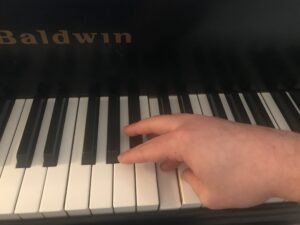 You can see how uncomfortable that looks. It’s also uncomfortable to turn with a finger other than your thumb. For example, if you play the F and the C with my thumb and fifth finger, you’ll have to contort you’ll hand to turn your third finger over your fifth to finish the melody.
You can see how uncomfortable that looks. It’s also uncomfortable to turn with a finger other than your thumb. For example, if you play the F and the C with my thumb and fifth finger, you’ll have to contort you’ll hand to turn your third finger over your fifth to finish the melody.
- What fingers can you use to play this melody most comfortably?
KEY #3: TAKE ADVANTAGE OF YOUR FINGERS’ DIFFERENT STRENGTHS
Your thumb is a heavy finger. Its natural tendency is to play a little louder than the other fingers. If you use a fingering that puts your thumb on notes you want to be particularly quiet, you’ll have to work harder to control the volume than if you use a naturally quieter finger there. The fourth finger is a naturally weak finger. Moving back and forth between the fourth and fifth finger is tricky.

This melody alternates between the E and the F at the top. So your first instinct might be to use four and five. But what fingers can you use to play this melody more conveniently? You’ll have your own preferences based on what feels best for your hand. The important thing is to find a fingering that lets you play the music as easily and as beautifully as possible.
KEY #4: LOOK FOR PATTERNS IN THE MUSIC
A lot of music uses something called sequences. A sequence is a melodic shape that gets moved up and down the keyboard. Usually, you can keep the fingering that works well for that shape no matter where it starts on the keyboard. If the sequence sometimes starts on white notes and sometimes starts on black notes, you might need to work out two different fingerings.
- What other patterns do you notice in your music?
- Can you find a fingering that works for every repetition of the pattern?
KEY #5: DIVIDE THE MUSIC STRATEGICALLY BETWEEN YOUR HANDS
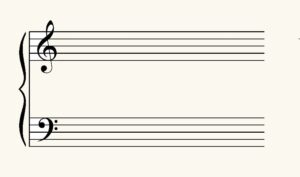
Most music is written on a grand staff, and usually the right hand plays what’s on the top staff while the left hand plays what’s on the bottom staff. But there’s no rule that says the right hand HAS to play from the top staff and the left hand HAS to play from the bottom staff. What you see on the paper is often something that’s convenient to PRINT and to READ, not necessarily something that’s convenient to PLAY.
In my own Fifth Piano Sonata there’s a passage where I hold a chord in the bass with the pedal while I play a melody in the upper treble and play quick notes in the lower treble. I need to have the lower staff in bass clef to show the held chord, so the quick notes have to be in the upper staff. But those notes have to be played with the left hand. There is simply no way to play both it and the melody with the right hand.
Unless you’re playing something the Ravel Concerto for the Left Hand Alone, it is not cheating to play with different fingers or different hands than what the printed music suggests. Composers want you to play their music as beautifully as possible. So if crossing your hands or finding a fingering the composer hadn’t thought of helps you do that, go for it!
A PDF and a video!
These are just a few of the keys to figuring out a really good fingering for any music you’re working on. Remember, your fingering should fit YOUR hand, be comfortable for you, be efficient, and help you play beautifully without having to worry about finding the next note.
I’ve put these keys into a free PDF that you can download: Piano Fingering: 5 Keys to Mastering the Technique. And I’ve made a video with all this information and some demonstrations. It’s right below, and you can also find it on YouTube as Piano Fingering: The Keys to Figuring it Out. Meanwhile, if you have any questions please comment below this post.
And if it would be helpful for me to work closely with you as you learn your music, please send me an e-mail through the contact form in the top menu to set up individual consultation.
And please subscribe to my e-mail list below so you can know as soon as I put up my next post. Until next time, happy practicing!
